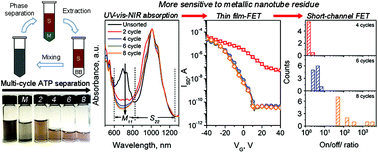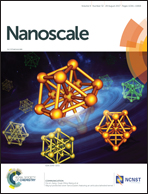Exploring the upper limit of single-walled carbon nanotube purity by multiple-cycle aqueous two-phase separation†
Abstract
Ultrahigh purity semiconducting single-walled carbon nanotubes (S-SWCNTs) are required for high-performance transistors. Aqueous two-phase (ATP) separation is an attractive method to obtain such SWCNTs due to its simplicity and scalability. This work targeted two questions; namely what is the upper limit of S-SWCNT purity that can be achieved by multiple cycles of ATP separation from the most commonly used polyethylene glycol and dextran system and how accurately can commonly used methods characterize the improvement in purity? SWCNT purity in nanotube dispersions obtained by multi-cycle ATP separation (2, 4, 6 and 8 cycles) was evaluated by three methods, including UV-vis-NIR absorption spectroscopy analysis, performance of thin-film field effect transistors (FETs) prepared by drop casting and short-channel FET devices prepared by dielectrophoresis deposition. Absorption spectroscopic analysis and the performance of the thin-film FET devices can hardly differentiate metallic SWCNT residues in the dispersions obtained after 4 cycles with the purity above 99.5%, and the short channel FET devices prepared by dielectrophoresis deposition are more sensitive towards tiny metallic SWCNT residues. A new method was also demonstrated to visualize the minor metallic content in the nanotube suspension using voltage contrast imaging in a scanning electron microscope, which enables rapid screening of many devices and the accurate obtainment of metallic content without performing a large number of individual transconductance measurements.



 Please wait while we load your content...
Please wait while we load your content...